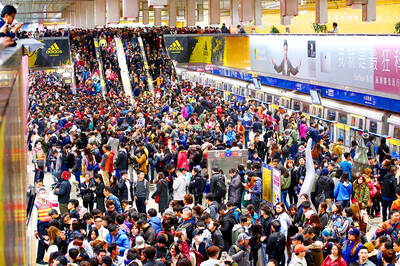The armed forces began their annual Han Kuang military exercises (漢光演習) yesterday, drilling troops and weapons mobilization for counter-strikes in the event of an invasion by China’s People’s Liberation Army (PLA).
Among the first day’s main activities was a live-fire drill by the big guns of the 21st Artillery Command of the Republic of China Army’s 6th Corps, which took place at the army’s Kengzikou (坑子口) target practice range in Hsinchu County.
President Ma Ying-jeou (馬英九) attended the event at the range to observe the firepower of the self-propelled M109 and M110 howitzers, where the troops drilled artillery strikes as part of an anti-amphibious-landing drill.

Photo courtesy of the Military News Agency
This week’s Han Kuang exercises last five days, with the Ministry of National Defense overseeing exercises at military installations and airbases across the nation, including on the nation’s outlying islands.
The National Security Council is also coordinating with the military to hold its two-day “Political-Military Exercise,” simulating cyberattacks against water and electricity facilities, and against central government ministries by China’s cyberwarfare units.
The National Security Council exercises train Web managers and digital security experts to respond to Chinese cyberattacks to get computer networks and Web sites back online.
Another main focus of the first day of the drills was protecting major weapons and maintaining the military’s fighting strength to mount counterattacks in the event of a first strike on Taiwan by the PLA.
Air force bases and radar stations in the west were mobilized for countermeasures, surveillance of enemy advancement and situation assessment, while fighter jets were flown to the mountain cavern aircraft hangars at Hualien County’s Jiashan Air Base.
Defense ministry officials said the military exercises include both active and reserve troops and are larger in scale than last year’s, with drills by the three main branches of the armed forces, and for the first time with the participation of the the Tuo Jiang (沱江) stealth missile corvette and the Panshih (磐石) supply vessel, weapon-carrying drones and US-made P-3C marine patrol aircraft.

People can take the Taipei MRT free of charge if they access it at Nanjing Sanmin Station or Taipei Arena Station on the Green Line between 12am and 6am on Jan. 1, the Taipei Department of Transportation said on Friday, outlining its plans to ease crowding during New Year’s events in the capital. More than 200,000 people are expected to attend New Year’s Eve events in Taipei, with singer A-mei (張惠妹) performing at the Taipei Dome and the city government’s New Year’s Eve party at Taipei City Hall Plaza, the department said. As people have tended to use the MRT’s Blue or

Civil society groups yesterday protested outside the Legislative Yuan, decrying Chinese Nationalist Party (KMT) efforts to pass three major bills that they said would seriously harm Taiwan’s democracy, and called to oust KMT caucus whip Fu Kun-chi (傅?萁). It was the second night of the three-day “Bluebird wintertime action” protests in Taipei, with organizers announcing that 8,000 people attended. Organized by Taiwan Citizen Front, the Economic Democracy Union (EDU) and a coalition of civil groups, about 6,000 people began a demonstration in front of KMT party headquarters in Taipei on Wednesday, organizers said. For the third day, the organizers asked people to assemble

Taipei is participating in Osaka’s Festival of Lights this year, with a 3m-tall bubble tea light installation symbolizing Taiwan’s bubble tea culture. The installation is designed as a bubble tea cup and features illustrations of Taipei’s iconic landmarks, such as Taipei 101, the Red House and North Gate, as well as soup dumplings and the matchmaking deity the Old Man Under the Moon (月下老人), affectionately known as Yue Lao (月老). Taipei and Osaka have collaborated closely on tourism and culture since Taipei first participated in the festival in 2018, the Taipei City Department of Information and Tourism said. In February, Osaka represented

Taiwanese professional baseball should update sports stadiums and boost engagement to enhance fans’ experience, Chinese Professional Baseball League (CPBL) commissioner Tsai Chi-chang (蔡其昌) told the Liberty Times (sister paper of the Taipei Times) in an interview on Friday. The league has urged Farglory Group and the Taipei City Government to improve the Taipei Dome’s outdated equipment, including relatively rudimentary television and sound systems, and poor technology, he said. The Tokyo Dome has markedly better television and sound systems, despite being 30 years old, because its managers continually upgraded its equipment, Tsai said. In contrast, the Taipei Dome lacked even a room for referees